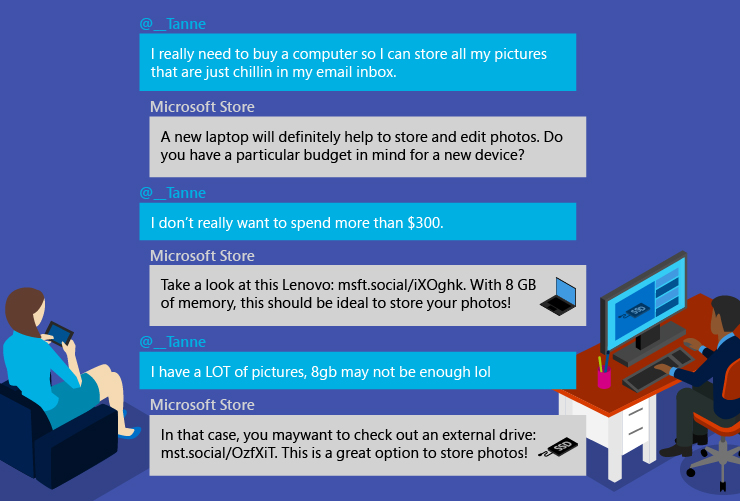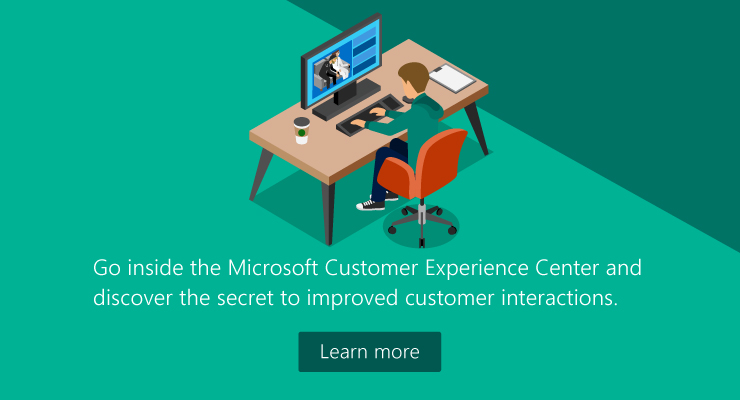
How Microsoft Stores use social media to humanize its brand
| Focus on: Empower Employees, Optimize Operations, Engage Customers |
Everyone has a social strategy. Retweets, custom content, clever quips—even not having a social presence is strategy within itself. In the Digital Era, modern organizations explore social for new opportunities to promote their brand, establish their voice, and engage their customers, but in the process, many overlook the power of the brand-audience conversation, and instead, produce single-sided content that speaks at their audience, rather than with them.
Since 2012, Microsoft Stores’ social team has been a part of the Microsoft Customer Experience Center (CXC). The brand’s online audience has since grown to an impressive 2.5 million, but just because the brand is a retailer doesn’t mean the primary mission is to sell, according to Microsoft Stores Social Media Group Manager, and two-year CXC veteran, Andrew Talevich. Microsoft Stores reactive social media team has three primary business objectives for how it interacts with customers online:
- Cultivate fans around the brand,
- Offer personalized product suggestions, and
- Provide real-time customer support.
Conversations that cultivate
“Fans,” defined as individuals who know, own, and use Microsoft products; recommend Microsoft products to others; and freely give feedback that they love Microsoft products, drive the bulk of Microsoft Stores’ conversations. According to Andrew, to cultivate new fans and nurture existing ones, Microsoft Stores capitalize on opportunities to surprise and delight their customers. The thing is, these are often spur-of-the moment engagements motivated by what the social team feels will resonate best with its followers.
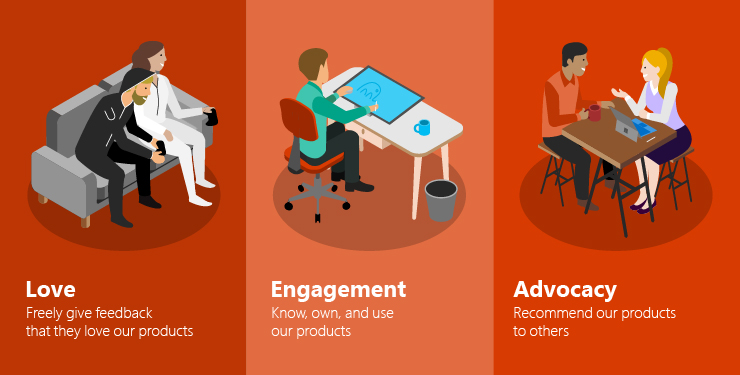
For example, a few months back, Microsoft Stores tweeted a post that featured two people wearing Xbox-themed onesies. The intention was to generate enthusiasm among the Xbox community, although, very quickly the team realized that its social community genuinely wanted their own Xbox onesies. After a quick brainstorm, Andrew and his team pulled together a campaign to select three of their favorite responses to the post, and, after a quick DM to let the individuals know they had won an Xbox onesie, were in the process of boxing up some brand-new onesies and shipping them out. This quickly planned surprise and delight campaign resulted in higher-than-average engagement numbers, and continued to gain a positive response on Reddit and across the web.
Events are another way Stores engages with its fans. The Stores social team prepares for major events, like new Store openings, by preparing a Q&A list ahead of time, and works with an in-person employee to interact with participants at the event in real-time and over social media. This practice encourages customers to share their own photos and experiences from each event and gives the social team another opportunity to select especially enthusiastic fans to win prizes.
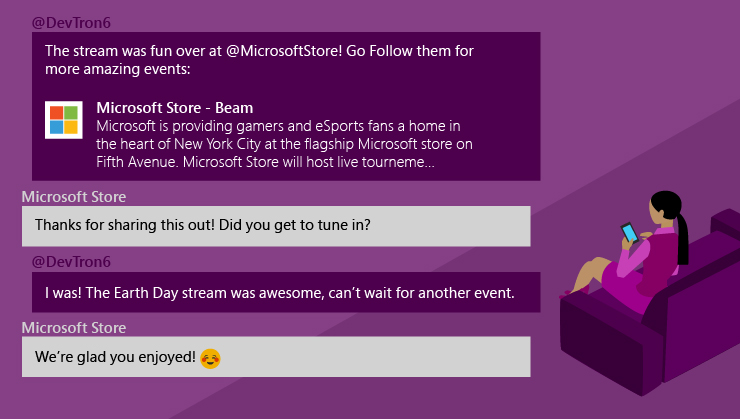 Social listening for improved product suggestions
Social listening for improved product suggestions
Oftentimes, customers end up shopping online for what they need, rather than visiting a physical store, because they want to avoid the oft-persistent salesperson. Microsoft Stores recognize and value the needs of these customers, and use a “friendly and authentic” method to approach these online customers with helpful, personalized suggestions.
Thanks to the social listening capabilities of Sprinklr, a social engagement tool that is hosted on Microsoft Azure, the Stores team has set up keywords that gather tweets from “anonymous prospects,” or people who have not directly engaged the Stores’ Twitter handle, discussing certain topics, like wanting a new laptop, being curious about HoloLens, or similar messages about wanting new technology.

After taking time to understand the customers’ needs, like their budget and lifestyle, the community manager will then offer up a product that’s tailored to what the customer might want to buy. A custom-tagged URL tracks when a customer clicks on the product link the community manager shares, and ultimately credits any generated revenue, website visits, and other metrics back to the social community manager who made the sale happen. This data-driven approach also helps the team optimize their social prospecting strategy based on the metrics they receive on those tagged URLs.
Real-time social and in-store support
The third business objective of Microsoft Stores social focuses on customer support. After recognizing that customer support over Facebook or Twitter is just as crucial as in-person support, Microsoft Stores established a support escalation team that receives support tickets from brick and mortar stores, the digital store, and over social media.
“With monitoring our social media channels throughout the day, we’re usually the first to see those issues, especially if there are customers tweeting about those issues,” Andrew says. “So, it’s imperative that we have a quick response and that we have a clear strategy about how to address these specific issues.”
Support issues vary from isolated incidents to national or global-level issues. “The issues can range from something minor, like someone has an order issue, which is something that can be solved by our CSS team. But sometimes we get more severe issues – store complaints, or multiple people had a negative experience at perhaps a store event or through a store associate.” In those cases, Andrew explains, the social team escalates the larger issue to their manager. The manager is then able to escalate the issue and message to the specific store manager for resolution.
This tie between social media and brick-and-mortar stores is crucial to the Stores brand. Negative in-store experiences can really hamper an individual’s perception of Microsoft. So, if a customer goes into a store and tweets about a bad experience, more often than not the customer will expect a real resolution to the issue, Andrew explains. With the speed of social media managed through Sprinklr, these negative customer experiences are often resolved within a few hours. This is important, says Andrew, because it ensures the customer with a negative experience becomes a neutral to happy fan – not a detractor.
In using the same support team across all outlets, customer profiles are consistently stored and updated through Microsoft Dynamics 365. This ensures a customer experience that, if negative, can be resolved quickly, and tracked through all potential retail outlets.
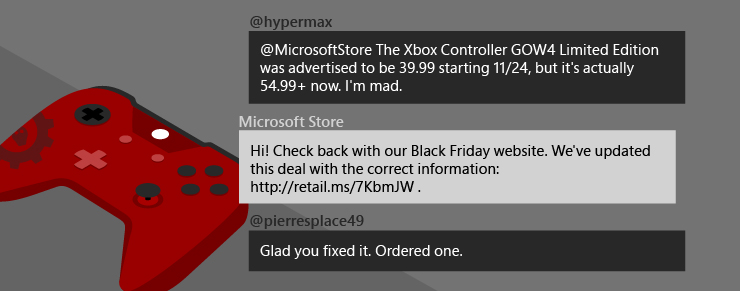
Supported with Sprinklr
For Microsoft Stores, social media is the pinnacle bond between traditional brick-and-mortar stores and digital shopping. Real people like Andrew monitor the social channels daily using Sprinklr, and it’s precisely this human element that makes Stores so relatable to its fans and customers alike. The team has a rich understanding of what a customer experiences both in-person and online, and this understanding bolsters each community manager’s ability to respond to social messages with an authentic, relatable tone.
Sprinklr is what makes all of this possible – from listening dashboards to support escalation – and, above all, it’s the tool that allows Microsoft Stores to meet customers where they are: on social media.
Related Content
- Read more Real Stories of Digital Transformation
- See the Customer Experience Center
- Go inside the Customer Experience Center and learn how to make your own

